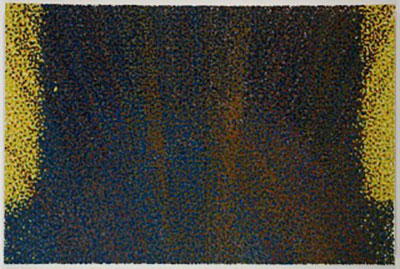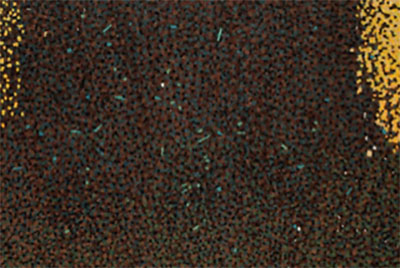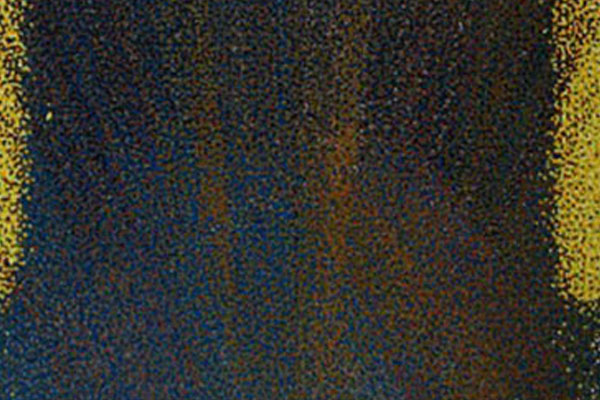Modernism in a Post-Modern Era
By Martin Mugar, WTP Guest Writer
There was a good deal of enthusiasm surrounding the late Andrew Forge’s exhibit this summer at the Betty Cuningham Gallery in New York City, but its title “The Limits of Sight” seemed mistaken. My first reaction was, whoever titled this show was making the grand claim that Forge was establishing the limits of vision once and for all by working in the domain of the optical world of cones, where color is activated in the retina, beyond which there is nothing.

I am sure that he did not make that claim himself. Impressionism employed this organizational strategy as Pointillism, most refined in the work of Seurat: a reality reduced to cone-generated dots that is known in the world of cognitive psychology as a lower order event. Structurally Pointillism is ground for and/or description of the visual world of things which, in cognitive theory, is a higher cognitive event. Seurat was not an abstract painter, but he utilized an abstract cognitive language of seeing as his underpinning of a representational world (and, of course, another contemporary practitioner of dots with representation as his underpinning was Chuck Close).
Forge jettisoned representational Pointillism to create these lower-order cognitive events. If you consider him in contrast to dot-meisters Richter, Hirst or Kusayama, the works of these artists are more self-conscious—Forge’s approach was one of the traditional hand-application of the brush to canvas, whereas with the latter, the dot is more derivative of graphic design. Although I was unable to actually attend in person this Forge show, I was able to zoom in on his “dots” which are decidedly thinly applied brushstrokes. This more traditional application of paint opens up his work to a gestalt of exploration; an almost religious feel of anticipation.

Moreover, Forge’s color choice is not color-packed as in Hirst or Richter. The effect is one of “where the painting is going to take the viewer” rather than of where the painting “is.” On the one hand, he abandons the representational goal of Seurat and Close but on the other, does not revert to the hard modernist approach that can leave the effect of the work dependent on its exhibition space. Forge opens abstraction to possibilities shut off to the post modernists mentioned above, that connection of the mark to repetition and hence, to time or the yearning and desire behind the mark.
It is not always so easy to find serious modernists who work with that intent, one of building clear and distinct visual interactions within their paintings, but I have in other venues referred to Dave Row, a student of Al Held at Yale, as an artist whose work is distinct from the work of formalists with whom he might easily be confused. Guyton, Kassay, and Grotjahn, for example, push the modernist ethos into a self-referential and ironic space, whereas Row establishes his own space within the painting itself, which was all the more evident in his exhibit at the Center for Maine Contemporary Art. It was probably one of the more perfect installations I have ever seen, the works symbiotic with the museum space. The large scale of Row’s works activated the space instead of the space itself overwhelming the works. There appeared an almost seismic shift in some of the paintings, so that the museum space seemed to move into the openings provided by fissured shapes.
Maybe this seamless interaction between space and work can leave you wondering whether there may be a point of overdependence on exhibition space. Then again, maybe this is like questioning whether Michelangelo’s nudes are overdependent on the space of the Sistine Chapel. In a Peter Plagens review of Row, Plagens takes issue with what he refers to as “fussed over surface” which did figure in some of the works in this the Maine contemporary art space. But I could imagine a body of work where the scratched or roughed-up surface was replaced by Forges’ probing pointillist marks. It would be a sort of hypertext that dug into the space of the canvas and at the same time reached out into the gallery space, though that is probably more than one artist could achieve in a lifetime.
Martin Mugar’s work has been included in numerous group shows, and in solo exhibitions at the Creiger Dane Gallery, The Bromfield Gallery and the MIT Museum, in Boston, and frequently at the Bowery Gallery in New York City, among others. It is also included in the public collections of The Weatherspoon Museum, The Danforth Museum, The Boston Public Library, Tufts University Museum, The Fuller Museum, Merrimack College and Simmons College. He received his BA cum laude from Yale College in 1971 and his MFA from Yale University in 1974. He has taught at the University of North Carolina, the University of New Hampshire, Dartmouth College, and the Art Institute of Boston.

